Want the convenience of PDF patterns, without the hassle of printing and taping at home? Copyshop printing may be just the thing you’re looking for! Here’s our step-by-step guide for printing PDF sewing patterns at a copyshop.

We love PDF patterns for the instant gratification—there’s nothing more satisfying than getting an idea for a project, buying and downloading the pattern, and sewing up the garment all in an afternoon, without ever leaving the house. But if you don’t have access to a printer at home, or find that taping up patterns takes the fun out of your favorite hobby, it might be time to try copyshop printing.
Printing your PDF patterns at a copyshop removes a bit of the instant gratification and adds a bit to the cost, but there are may benefits to printing your patterns at a copyshop. We’re going to get into all that in just a bit, but let’s start at the beginning.
(Want to start at the very very beginning, with what a PDF sewing pattern even is? Check out our beginner’s guide to PDF patterns here. )
What is copyshop printing?
Typical home printers print on relatively small sheets of paper, but sewing pattern pieces can often be much larger than a single sheet of letter or A4 paper. Copyshops (like Staples and Kinkos) are stores that have large format printers that are able to print really big sheets of paper—ones that are several feet long and several feet wide. Printers of that size are great for printing posters, blueprints, and of course, sewing patterns.
When you print your PDF pattern at a copyshop, what you end up with is a large sheet of paper (or several sheets of paper) with your pattern pieces printed on it. Historically, you’d have to take your PDF pattern to a physical copyshop in your local area to get it printed. However, it was often outrageously expensive at the chain stores—typically more than the pattern itself! Thankfully there are now a number of great online copyshop options and many of them are cheaper than your local copyshop—more on that in a bit.
Why print my PDF patterns at a copyshop?
There are a number of reasons why some sewists prefer to print their PDF patterns at a copyshop. Printing at home is great, since it truly is instant gratification, but not all of us have printers at home or the patience to tape together the printed pages. (Learn more about printing PDF patterns at home here.) So the next best thing is to print your pattern at a copyshop—no trimming or taping required!
There’s pros to each type of pattern and each type of printing, and thankfully with multiple options you can find the method that works best for you.
Is it expensive to print PDF patterns at a copyshop?
When you buy a PDF pattern, it usually costs less than the printed pattern, and you definitely save big on shipping, since there are no shipping costs for digital patterns. Printing digital patterns at a copyshop is not free (unless you’ve got a personal connection somewhere, in which case boy are we jealous!) but it also doesn’t have to cost a lot of money. Depending on where in the world you live, there may be cheaper and more expensive options.
The most convenient copyshop option—the kind that you can drive to and use in person, like a Staples for example—is likely also going to be the most expensive. You can usually find a better deal at on online copyshop, although you may have to pay for shipping and wait a few days to get your pattern delivered to you. We’ve spent the last few years collecting intel about cheaper copyshop options around the world, and we’ve gathered it all into a blog post here.
Don’t see options that are local to you on our list? We recommend googling terms like “engineering print printing”, “plan printing”, “blueprint printing” or “reprographics printing” to uncover more options in your area.
Some online copyshops, like PDFPlotting.com, have minimum order costs and flat shipping, so we recommend sending a few patterns off to print at the same time to save on the cost per page.
How to print PDF patterns using a copyshop
We’re now going to go through the process of printing your pattern at a copyshop. Make sure you’ve purchased, downloaded, and saved your PDF pattern, and opened the ZIP file to reveal the files inside. (Need help with any of those steps? Check out our guide here.)
We’re going to use the Turner Dress as an example. Let’s take a look at what’s inside our Turner Dress PDF pattern folder:
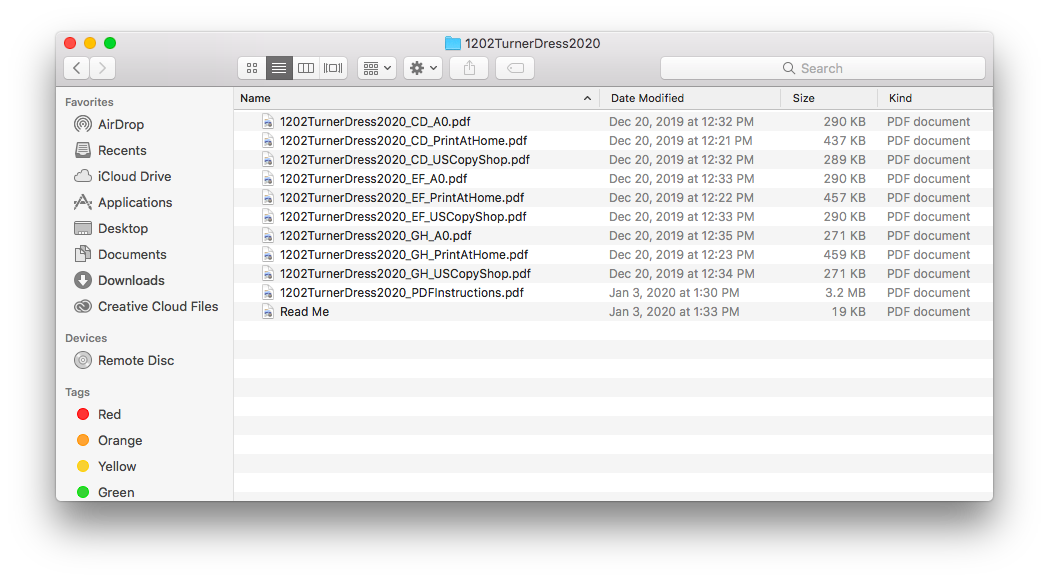
It seems like a lot of files at once, but don’t worry! You won’t need to use all of them. Let’s talk through each file type, one by one.
- Read Me file: start by opening this file—this will help you understand which files you’ll want to print for which cup size or pelvis option.
- Instructions file: Everything that you would find in the instructions booklet and envelope of a printed pattern can be found in this file for a digital pattern! You can choose to print it off (on letter/A4 paper, not on large format copyshop paper!) or view it digitally.
- US copyshop and A0 files: These files contain the pattern pieces, laid out on large documents designed for large-format printers. You’ll notice that the copyshop and A0 files are separated out by cup size. That’s because this dress, like with all of our patterns, comes in three cup size ranges: C/D, E/F, and G/H. We’re separated the three size ranges out into three separate files, so that you only print the cup size that you need—nothing extra. If you need help choosing your cup size, go here.
- Print at home files: These files contain the pattern pieces, divided out into smaller pieces of paper suitable for a home printer. For more on how to print PDF patterns at home, go here.
What’s the difference between copyshop and A0?
Cashmerette copyshop files come in two formats, “US Copyshop” (36 inches by 48 inches) which is the paper size in America, and “A0” which is the most common paper size everywhere else.
Whether you’re in the US or elsewhere, it’s always best to double check the recommended paper size for the copyshop service you’re using to make sure that the pattern you’re printing will fit. (If they haven’t made it clear what size paper they use, ask!)
Opening your PDF pattern in Adobe Reader
Pattern designers use the PDF file format because it protects the contents of the document—namely the pattern pieces, labels, markings, and so on—from shifting around when the document is opened on different computers.
The PDF file format is widely used and can be opened by the majority of computers and devices, but we recommend using Adobe Acrobat Reader anytime you want to print a PDF pattern. This is program that you can download on your computer and use for free.
Once you’ve downloaded Adobe Acrobat Reader, click to open it. Then you can go to the menu to File > Open to open the pattern file you want to print. (Remember to select the copyshop or A0 version of your cup size.)
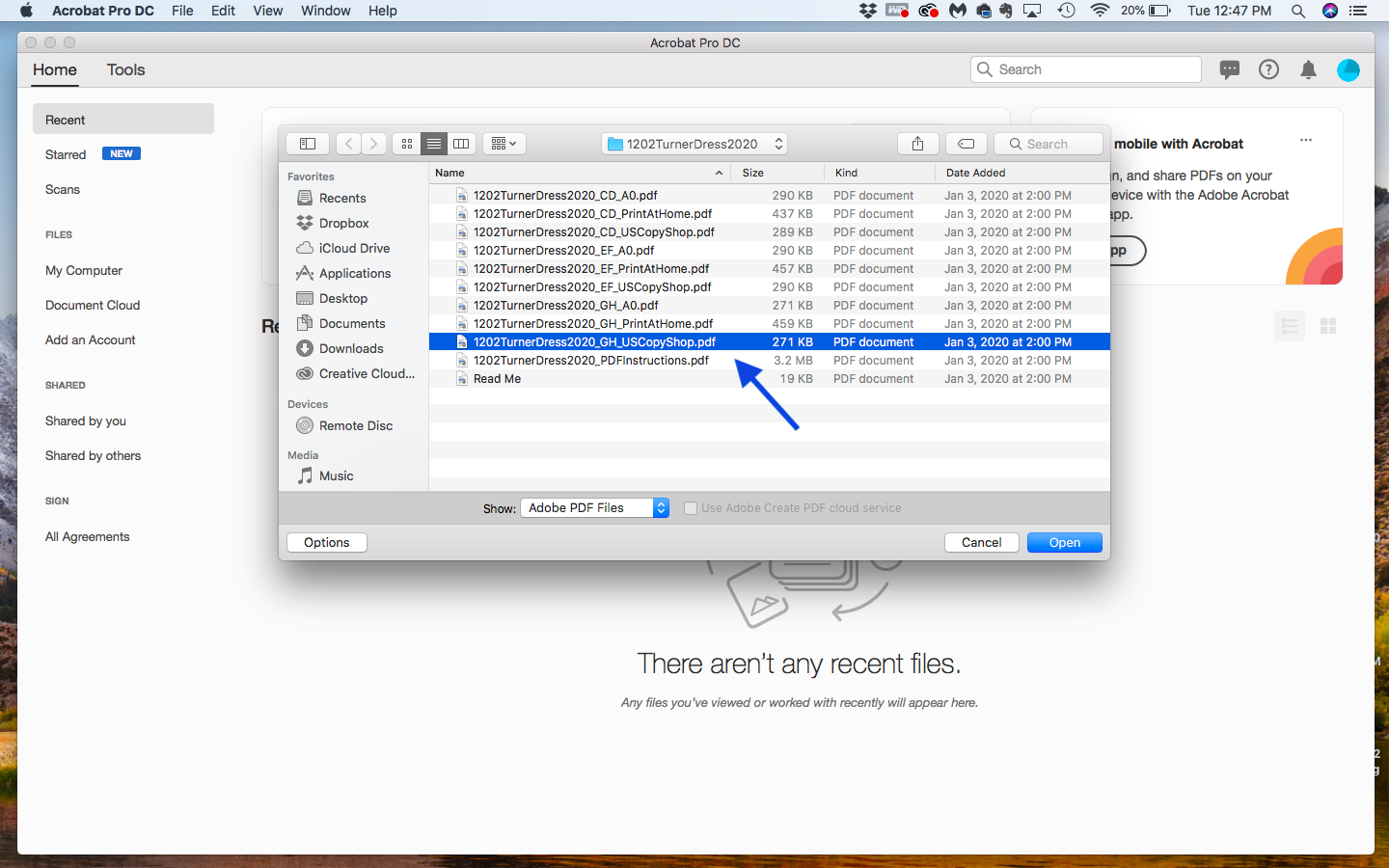
There are a couple of important things to look for before you send your pattern off to the printer. These include:
- Check the number of pages. You can see this in the tools bar near the top of the document window; if you’re on the first page, you’ll see “1 / 2” or “1 / 3” which will tell you that there are 2 or 3 pages in total. You can also click on the page thumbnails icon in the left-hand menu to view all of the pages as thumbnails
- Check the document size. Cashmerette patterns are 36”x48” for US copyshop files and 33.1”x46.8” for A0 files, but it’s always good to double check before send a document off to the printer. To check a file’s document size, go to File > Properties and look down to where it says “Page Size”, you can get set it so that the document size always displays by going to Adobe Acrobat > Preferences > Page Display and checking “Always show document page size”. Then the document size will always display in the bottom left corner of your image.
- Check the cup size or pelvis fit. Cashmerette patterns come in three cup sizes (C/D, E/F, G/H) for tops and dresses, and may come in two pelvis fit (apple, pear) for pants and skirts. We’ve separated the cup sizes and pelvis fits into separate files so that you only print what you need. Double check that you’ve selected the right cup size or pelvis fit for you, and if you need help choosing your cup size or pelvis fit, go here.
- Look for a test square. All copyshop files should have a test square, which helps you check that the file was printed at the right scale once you get it back from the printer. Even a 5% difference in scale can make a really big difference when you sew up your garment, and the only way to know if a pattern has printed correctly is with the test square.
- Do a gut check. Does everything look okay? Are all the pieces there? Did the document download completely, with no lines cut off? At Cashmerette, we strive for 100% perfection with our pattern files, but with variation across PDF pattern companies, it’s hard to know how thoroughly pattern files have been reviewed. It never hurts to double check before paying for printing!
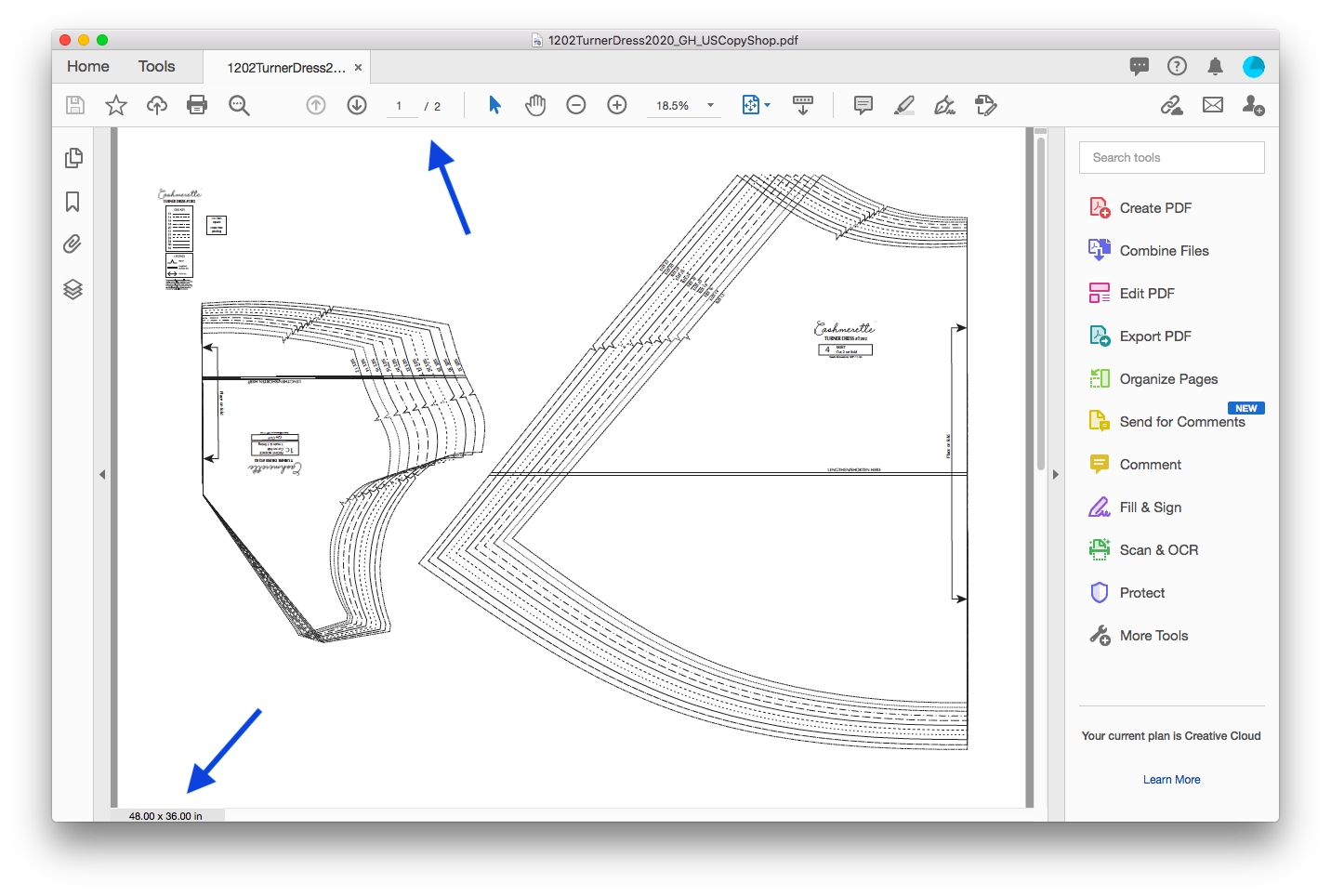
Uploading your PDF files to an online copyshop
The process for sending your files to an online copyshop can vary from shop to shop. We’re going to go through the process of uploading to PDFPlotting.com, which seems to be one of the most popular online copyshops in the US at the moment. (Note that we are not affiliated with PDFPlotting.com in any way.) You should always check with your copyshop about their process for uploading and submitting files, and if you don’t see clear instructions on their website, email or call them to get the info you need.
PDFPlotting.com has conveniently created a video tutorial for how to place a PDF pattern order on their website. Here it is:
Let’s go through that step by step.
Go to PDFPlotting.com in an Internet browser. From the menu, select Pattern Printing > B&W Pattern Printing.
All Cashmerette patterns can be printed in black and white, which is usually cheaper than color printing. However, some pattern companies may use different colors to differentiate between sizes, so check the copyshop document to see if color printing is needed.

You’ll then see that there are a number of page sizes to choose from. Keep in mind that these size categories can accommodate documents up to that size. For example, if you have a document that is 32”x46”, you can still use the 36”x48” printing option (but don’t use the 30”x42” printing option since your files will get cut off).
Scroll down to the “A0 and 36” x 48” option.

Click on the dropdown below “# of Pattern Pages” and select the number of pages in your document. Note that this is per pattern, so even if you are sending several patterns off to the copyshop at once, you should select only the number of pages in the particular pattern you’re uploading at that moment.

Once you’ve select the number of pages, you’ll see a few more options have been revealed. You can choose the number of copies you want to order of that particular pattern (this can be helpful if you know you want to make it in multiple sizes, like for yourself and a friend). Otherwise, you can leave it at 1 copy.
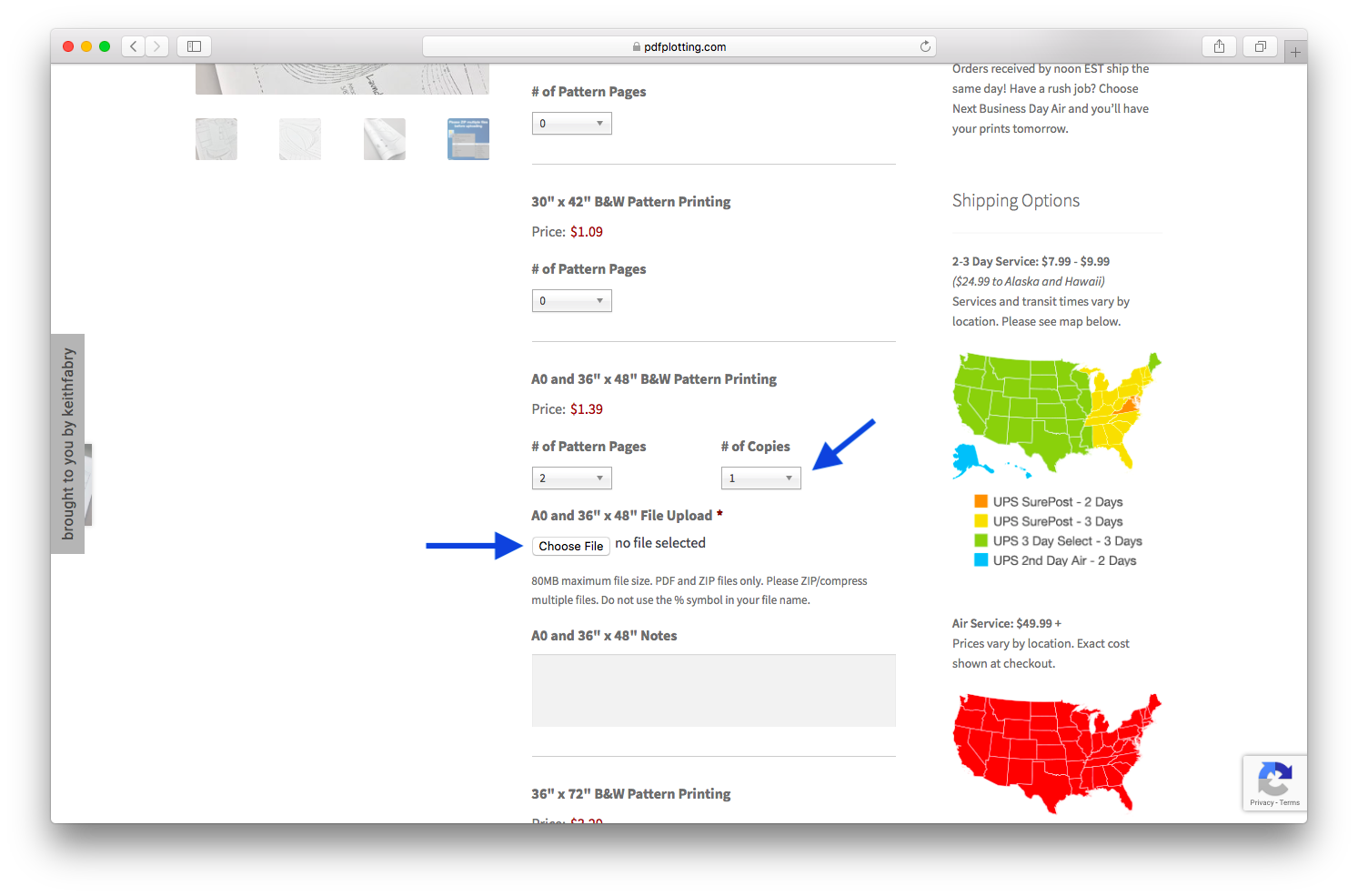
Click “Choose File” and navigate through your file folders to find the copyshop or A0 file that you want to print. Again, remember to select the right cup size or pelvis fit for you.
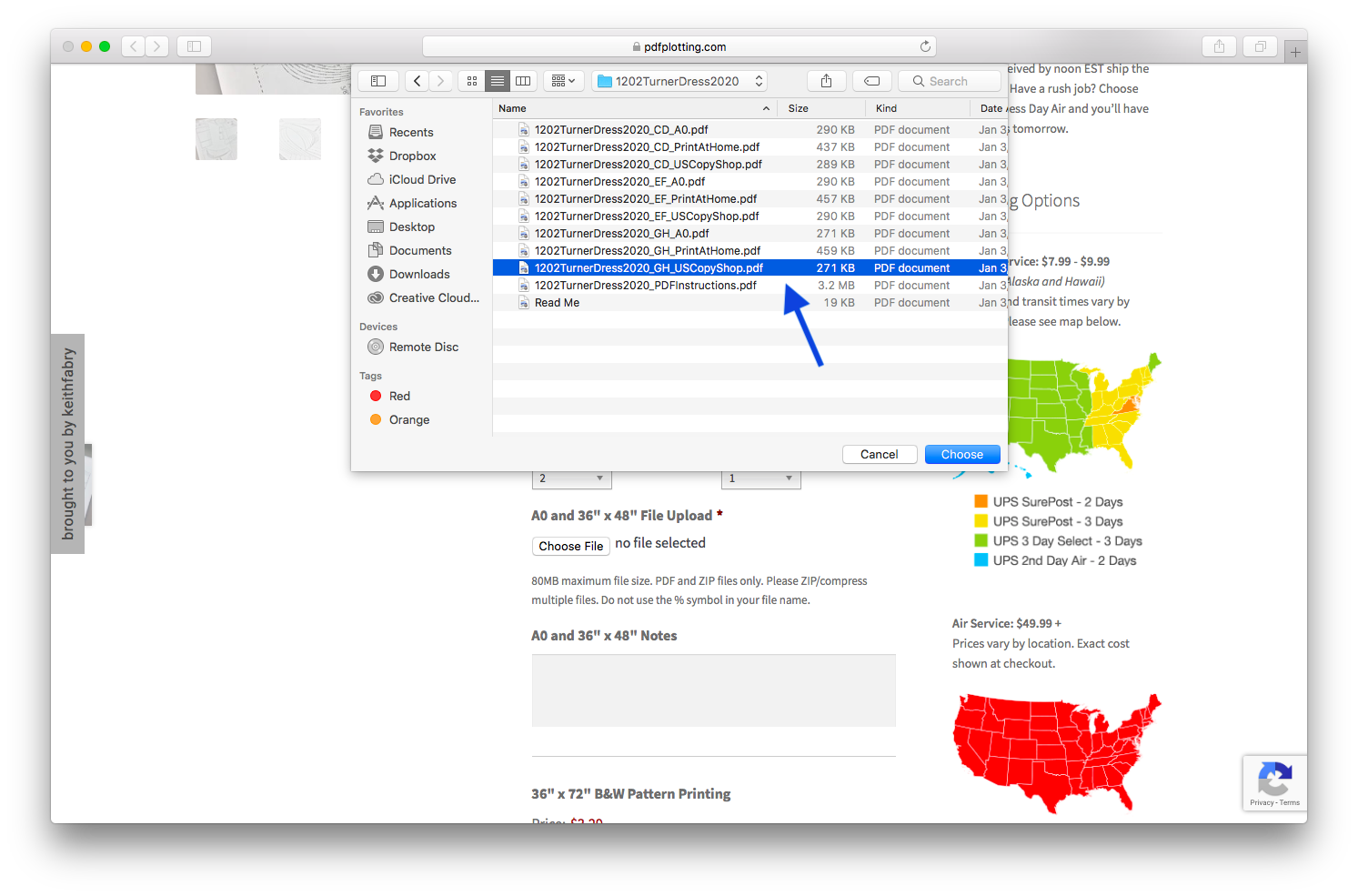
You’ll then see a shortened version of the file name next to the “Choose File” button. Your file won’t start actually uploading until you click “Add to Cart” at the bottom of the page.
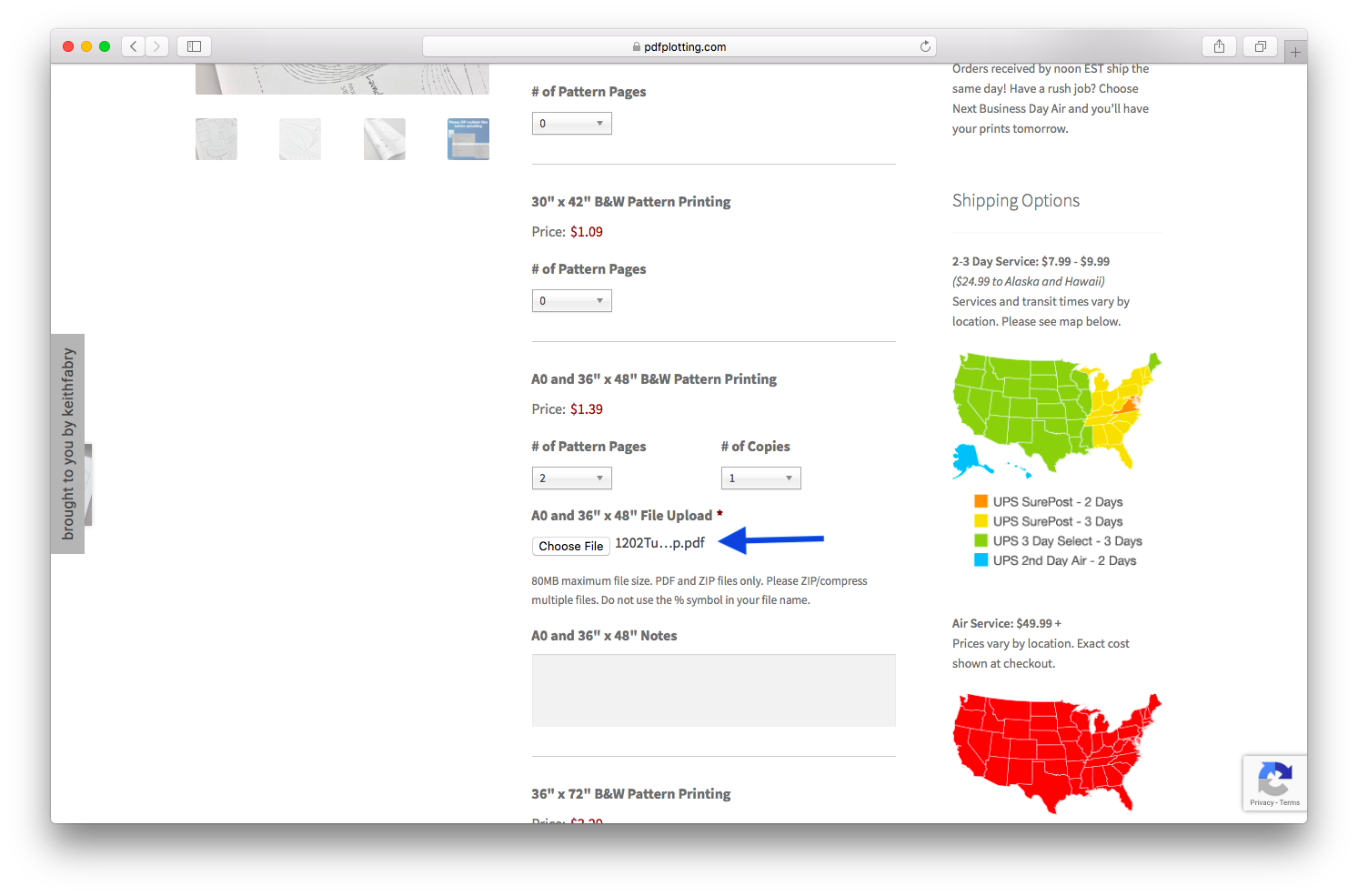
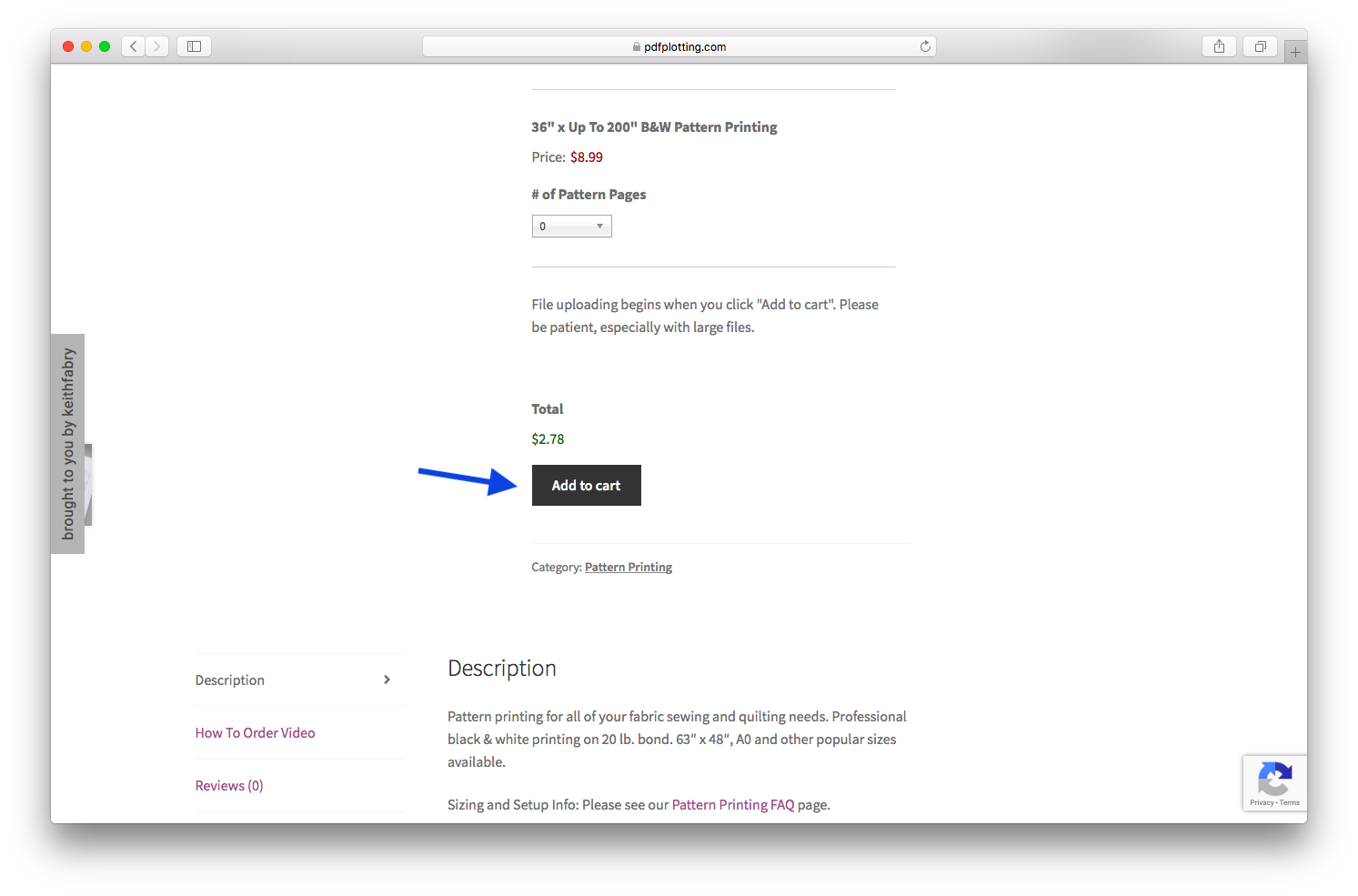
From there you’ll be taken to your cart, where you can confirm that everything is correct for your pattern—document type, number of pattern pages, number of copies, and file name. You’ll also see the price for that pattern.
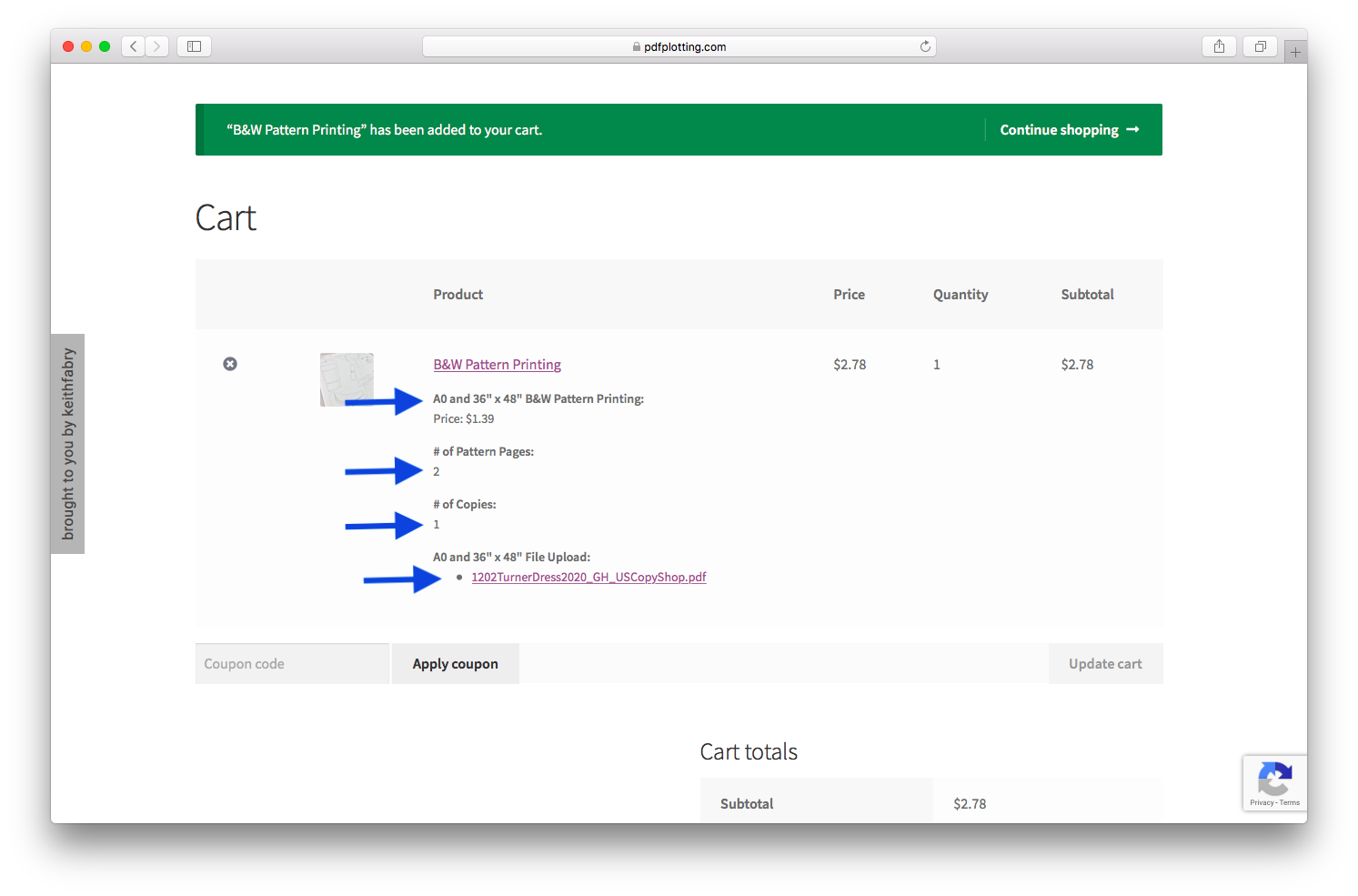
PDF plotting has a $7.50 order minimum at the time of this writing. We recommend sending several patterns off for printing at the same time so that you’re not charged the order minimum surcharge you see here.
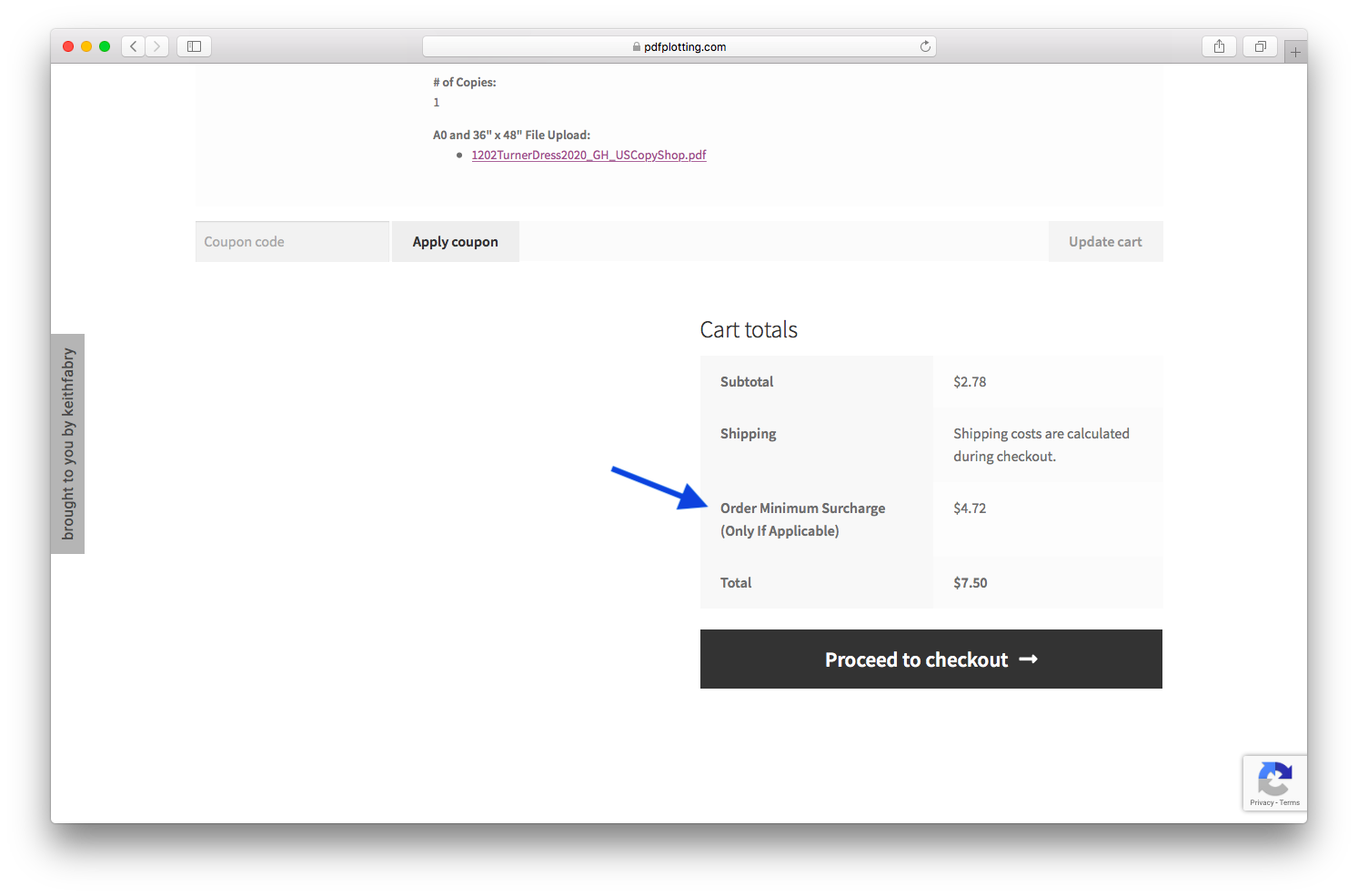
To add patterns to this same order, click “Continue Shopping”, then follow the same process to add other patterns to your order.
Once you have all of your patterns uploaded and in your cart, scroll to the bottom of your cart and click “Proceed to Checkout”. From there, you’ll be prompted to add enter your shipping and billing information and to place your order. And then we wait for our beautifully printed patterns to arrive!
At this time, PDFPlotting.com does not accommodate printing specific layers. If you have additional questions about ordering, printing, or shipping from PDFPlotting, check out their FAQs here.
Other methods for printing at copyshops
The process for placing orders at online copyshops vary by shop. Some may require you to create an account and log in before you can upload files. Others simply have you email the pattern files to a specific email, and then they will send you an invoice to be paid before they print and mail your patterns. It’s best to check with the copyshop of your choosing to make sure you’ve placed your order correctly.
If you’re taking your PDF pattern to a copyshop in person, such as Staples or Kinkos, we recommend bringing your files on a USB stick. If you don’t have a USB stick available, some copyshops allow you to download and print files from your email, so send your pattern files to yourself in your email. Check with your local copyshop for their preferred method before driving over.
Be sure to check out our guide for cheap copyshop printing options to find more cost effective printing options in your area.
Final thoughts on copyshop printing
Printing your digital patterns at a copyshop can save you a lot of time and effort on printing and taping patterns at home. It can be a bit intimidating, but we hope we’ve made it a bit more approachable in this guide.
If somehow you have access to a large format printer (such as through your work), you can of course use these same files and print patterns out yourself. Follow our checklist for what to look for before printing, but also double check that you’ve printing your files at 100% scale. Any bigger or smaller will result in a too large or too small garment, which is not fun to discover after hours spent sewing.
If you still have questions about copyshop printing, let us know in the comments below! We’re happy to help you, and soon you’ll be on your way to printing your first copyshop PDF pattern.

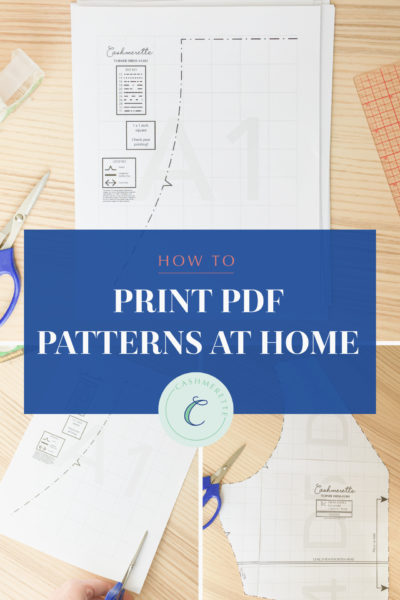
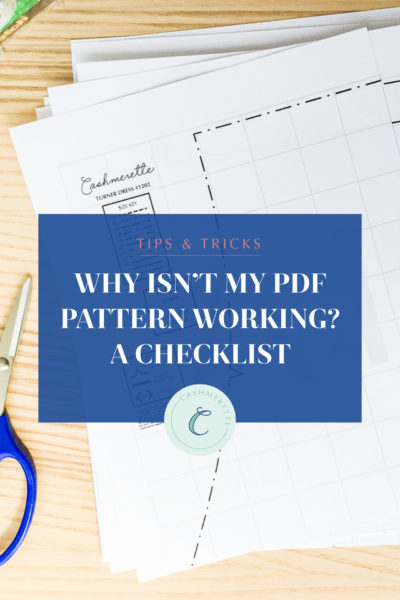
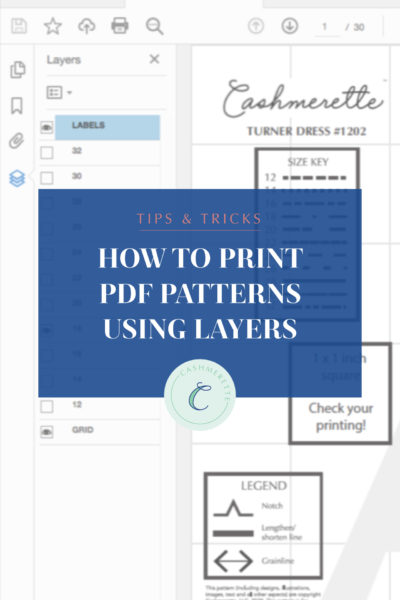
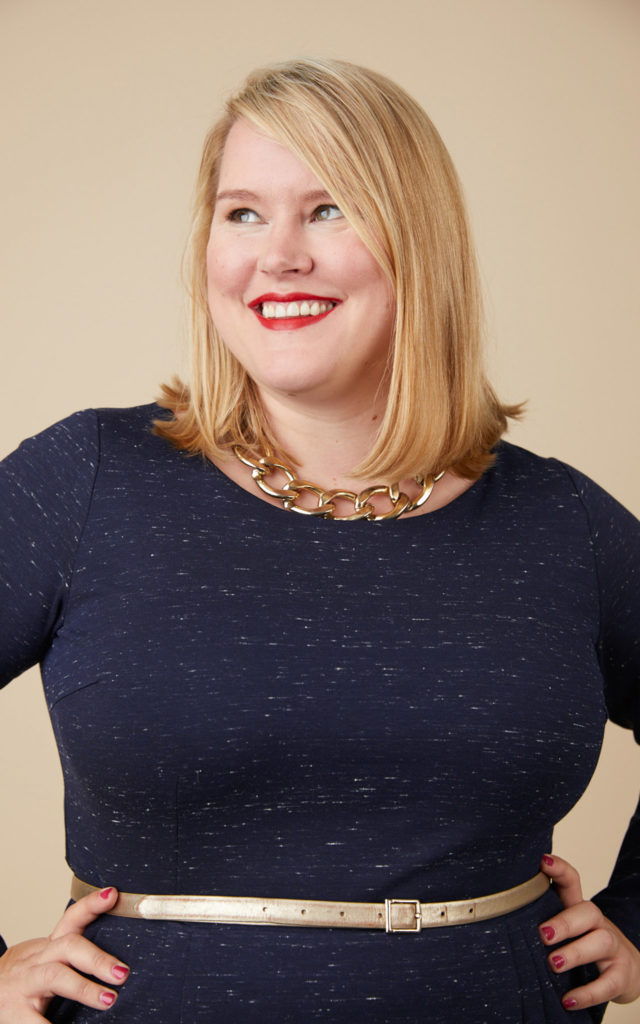
FYI: Would it not be simpler just to go back to paper patterns??????? I have a Mac and have not had any luck with the Adobe Reader. I might if I had the Professional Adobe Reader. I have tried Staples and it did cost a lot for them to print.
We are currently not shipping paper patterns because there is a stay at home advisory in Massachusetts. We all use Macs and Adobe Reader at Cashmerette and it works well, and there’s no need to have a professional version – if you’re still having issues, feel free to email us at hello@cashmerette.com. As we explain in this blog post, Staples is often very expensive, but other services like pdfplotting.com are considerably cheaper.
Adobe has it’s issues too in the tech world in general (married to a software engineer who is worried about it being on our computer) so I’m not surprised. How about try https://patternprintingcompany.com/ he evidently has decent reviews from peeps on Sewing Pattern Review but only prints A0 format. you arent required to look up the sizes of the document. a little more expensive per page but probably when looking at it overall with shipping might be cheaper.
What is AO format How can I get my sheet of pattern copied into my PC?
Although I could select and save just my size on a New Horizons pattern, when I sent that file to pdfplotting.com, the printout was every single size, not just mine. The owner said that this is the only option; unable to print out just my size.
Is there a specific type of paper to request? I assume we want a sort of tissue paper, not regular paper?
Most copy shops print on regular paper. But if you have a choice, you can choose whichever kind of paper you prefer to work with. There are benefits to both types.
-Ayelet at Cashmerette
Some shops also offer velum, which is somewhat see thru and stiffer than paper. It’s interesting, but also costs more. A shop once accidentally printed on it for me, and it was a cool alternative. I think I’d get it if I were matching plaids or something similar.
You can buy a couple of kinds of tracing paper for sewing from Amazon. If you want to be able to see through and trace just your size from a multi-size print, or combine sizes, or if you want to place your pattern on the fabric to match something in the fabric, you could use. They may be available elsewhere, of course.
PDF Plotting recently changed to automatically discover page size and number of pages, so there are less steps now.
Would you please list plotting companies? Im in the VA MD DC area
Check out our How to print PDF Copyshop files cheaply blog post for suggestions.
-Ayelet at Cashmerette